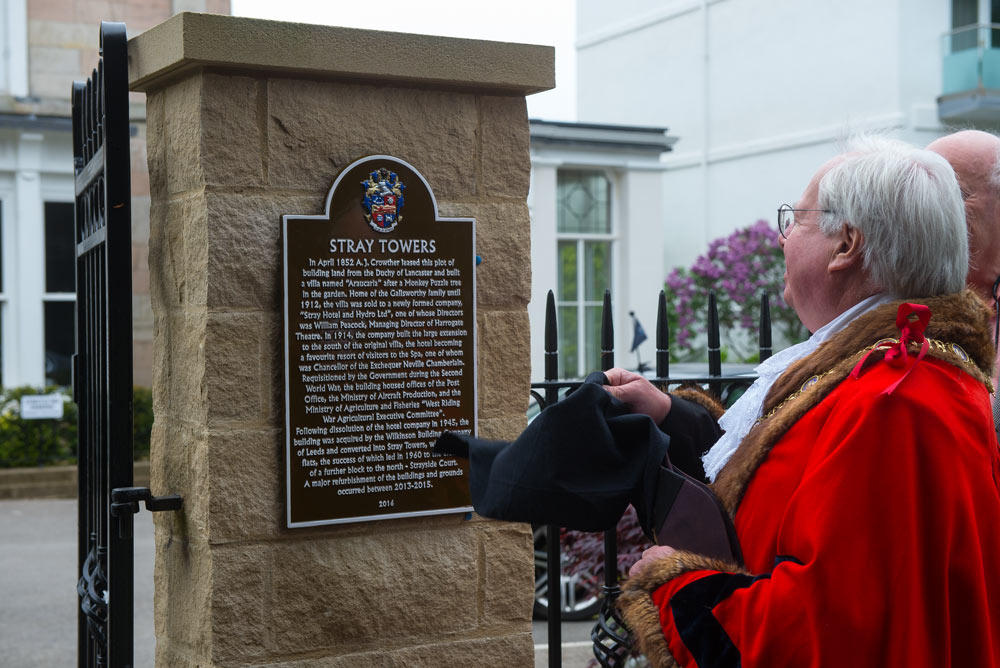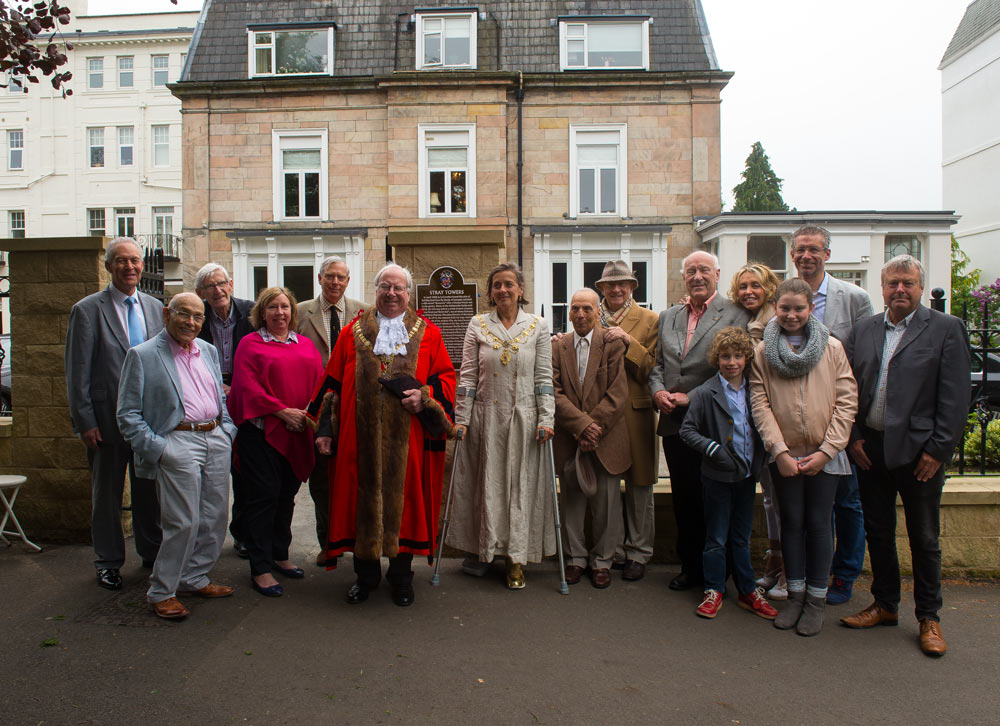The Mayor of Harrogate Councillor Nick Brown and the Mayoress Linda Brown unveiled a brown historic plaque at Stray Towers on Saturday 4 June 2016.
The residents of Stray Towers told the Mayor and Mayoress that many people walking along The Stray often stopped to look at the block of flats so it was thought that it was worth having one of Harrogate’s distinctive plaques to set out some of its interesting history.
Residents expressed their thanks to Malcolm Neesam, who was present, who had drafted the text of the plaque.
The original villa goes back to 1852 and, as Holderness House, it features in the novel ‘Precarious Fortunes’, due to be launched later in this month, written by Ian Townsend who owns one of the flats.
The villa became a hotel around 1912 and was extended in 1914 – amongst the visitors was Neville Chamberlain when Chancellor of the Exchequer.
During WW2 the hotel was requisitioned for government offices (The Post office, Ministry of Aircraft Production, a West Riding Committee of the Ministry of Agriculture and Fisheries), did not reopen as a hotel post war, and was converted to flats in the 1950s.


Local historian, Malcolm Neesam, explains about the history of Stray Towers
In April 1852 developer A.J. Crowther leased a plot of building land on the Duchy of Lancaster’s Red Bank estate in Harrogate, on what later became Byron Walk, and built a villa named “Holderness House”. For much of the nineteenth century, the villa was home to the Gallsworthy family, who named it “Araucaria” after a Monkey Puzzle tree in the garden. In 1912, the villa was sold to a newly formed company, “Stray Hotel and Hydro ltd”, one of whose Directors was William Peacock, Managing Director of Harrogate Theatre. The company built the large extension to the south of the original villa in 1914, the hotel becoming a favourite resort of visitors to the Spa, one of whom was Chancellor of the Exchequer Neville Chamberlain. Requisitioned by the Government during the Second World War, the building housed offices of the Post Office, the Ministry of Aircraft Production, and the Ministry of Agriculture and Fisheries “West Riding War Agricultural Executive Committee”. Following dissolution of the hotel company in 1945, the building was acquired by the Wilkinson Building Company of Leeds and converted into Stray Towers, with eighteen flats, the success of which led in 1960 to the erection of a further block to the north – Strayside Court. A major refurbishment of the buildings and grounds occurred between 2013 – 2015. In 2016, the current owner of the original villa, Ian Townsend, published his novel “Precarious Fortunes”,which is based on the visits to Harrogate of Baroness Angela Burdett-Coutts, the richest woman in Victorian England after the Queen. The novel, part historical romance, part mystery thriller, imagines an attempt to kidnap the heiress during one of her many recorded visits to Harrogate. Using real settings, such as “Holderness House”, as well as historical personages, Ian Townsend’s finely crafted novel develops in a logical and gripping manner, ending with a most satisfying conclusion.
Angela Burdett-Coutts [1814-1906] had first visited Harrogate as a child with her actress step-grandmother Harriot Mellon, who married the banker Thomas Coutts. After inheriting Coutts’ estates, Harriot married the Duke of St. Albans, and in 1837, both vast fortunes passed to Angela. The following year, Angela returned to Harrogate where she became a regular visitor at the Queen (today the Cedar Court) and Granby Hotels. In 1874 Angela presented a clock to the town which was displayed in the Market clock tower from 1877 until 1990. Her great wealth, and her friendship with Charles Dickens and the Duke of Wellington enabled her to carry out innumerable acts of national philanthropy which relieved the lives of the destitute.








